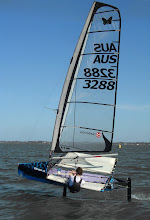CFD has been - and probably still is - the realm of people who know what they're doing. However recently Autodesk released a little bit of software called Vasari, which is really a software preview of some of the things that might be available in future versions of Revit. The 'wind tunnel' in Vasari is admittedly a bit crude compared to other things on the market, so you have to take the results with a grain of salt, but it does seem to give a reasonable impression of what goes on.
The thing I have been initially trying to test for ís whether the hull tramps in any particular configuration acts as sail, or otherwise increases the efficiency of the sail. This could probably come about in a couple of ways:
An early hypothesis is that the vortex trailing off the tramp actually seems to counteract the one from the bottom of the sail slightly. When you have a full tramp, that vortex seems to work better than with a small tramp. Just an early theory though.
The thing I have been initially trying to test for ís whether the hull tramps in any particular configuration acts as sail, or otherwise increases the efficiency of the sail. This could probably come about in a couple of ways:
- The wing tramps act as an end plate, and reduce the size of the vortex coming off / wrapping around the boom
- The leeward tramp generates lift in a downward and to windward direction when the boat is heeled strongly to windward, acting as not very productive sail
- A fixed foredeck fairing of whatever size could generate lift as long as the AOA is reduced somehow so it doesn't stall, or it is a very high stall angle section
- A fixed fairing might fill the gap between the deck and the boom and increase the end plate effect, even if it is stalled.
- The underwater profile of the hull generates lift
There has been mention on Facebook that there might be some legality issues with fixed aerodynamic fairings attached to the hull. I couldn't immediately see where aerodynamic fairings of this sort were ruled out, but please if you want to comment do so, I want to open up the discussion.
a couple of screen vids showing the airflow over different tramps, all other things remaining equal:
a couple of screen vids showing the airflow over different tramps, all other things remaining equal:
An early hypothesis is that the vortex trailing off the tramp actually seems to counteract the one from the bottom of the sail slightly. When you have a full tramp, that vortex seems to work better than with a small tramp. Just an early theory though.









